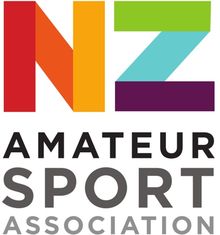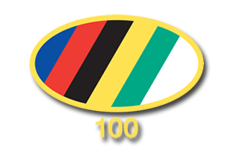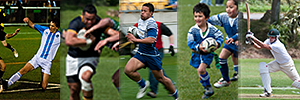Wellington against International teams: versus Great Britain 1930

Above: spectators on the once notorious western bank at Athletic Park settle in to watch Wellington take on Great Britain in 1930
Match details
Result: Wellington 12 – Great Britain 8
When: 4 June 1930, at Athletic Park.
Weather: Fine, with a cold wind from the south.
Crowd: 30,000
The tour
New Zealand was awash with rugby fever in 1930 when the second official full Great Britain (and first since 1904) landed on its shores for a 21-match tour. This was the first Great Britain team known as the Lions.
This tour was not without controversy. Not for anything off the field, rather the tactics of New Zealand’s teams on it. At the time all New Zealand teams packed down a 2-3-2 scrum with a ‘wing forward’ who put the ball in and then acted as a blocker on attack and an in-your-face tackler for the opposition teams’ inside backs on defence. Wellington teams, in particular, had produced several notable wing forwards, such as Thomas Ellison (Poneke) and William ‘off side Mac’ McKenzie (Petone) in the late 1800s. New Zealand attacking back play was swift and fast and gave rise to several stars such as midfield genius Bert Cooke (Hutt) who played for Wellington at this time, although he missed this game.
The British teams had long ago adopted the [current] 3-2-3 scrum formation with side row forwards bound until the ball was in play and the halfback feeding the loosehead. Wellington’s current captain was wing forward porter Cliff Porter (Athletic), an experienced practitioner in the ‘rover’ position. Great Britain’s manager, James Baxter, was none too pleased, calling Porter out for cheating and lobbying for New Zealand’s style of scrummaging and wing forward play to be outlawed, which it was by the IRB in 1932.
New Zealand won the Test series 3-1, Great Britain winning the opening Test in Dunedin 6-3 but the All Blacks (playing in white as the Lions wore dark blue jerseys) prevailing 13-10 in Christchurch, 15-10 in Auckland and 22-8 in Wellington.
In their first four matches, Great Britain confidently defeated Wanganui (19-3), Taranaki (23-7), Mana-whenua (34-8) and Wairarapa-Bush (19-6), before turning to face their first tough assignment in Wellington. They named their best team for their first run of the tour on Athletic Park.
For Wellington, this match was their first representative game of a memorable 1930 season. Wellington ‘A’ teams played nine games this year, for eight wins and a draw – the first time since 1919 that the ‘A’ team had gone through the season without a loss.

The match
Wellington was at a standstill on the morning of the match, a Tuesday. Athletic Park was chocker and gates were closed long before kick-off. But the crowds outside wanted in so much that they charged the gates and thousands more burst in to swell the official 30,000-strong crowd.
Playing into a strong southerly, Great Britain silenced the throng with an early converted try to Welsh wing J.C Morley. This fired up Wellington’s forwards who started dominating. Porter dropped a goal and then fullback L.K Heazlewood (Athletic) slotted a monster penalty. Second five-eighth Mark Nicholls put Wellington back on attack with a raking kick, leading to a converted try to hooker C.A McPherson (WCOB). Wellington led 12-5 at halftime.
Would this lead be enough the Western Bank faithful asked as they rolled their halftime cigarettes and swigged from their hip flasks? Great Britain launched a furious all-out assault, creating several clear chances. But Wellington’s defence held. Finally the visitors landed a penalty, but this was all they could manage as Wellington dug deep to the end to record one of the union’s proudest victories before or since.
Post-match the crowd surged on to the field to cheer their heroes and cart them off shoulder high in triumph.
In its report the next day, the Evening Post was generous in its praise. “Whatever else is in store before the tour finishes, the visit of the 1930 British Rugby Football team to New Zealand will long be remembered for one exceptionally thrilling contest that in which Wellington’s representatives lowered the colours of the finest rugby side that ever left Great Britain’s shores.”
The teams
Wellington: E.C. Coulston, E.M. Jessep, W. Peck, C.A. McPherson, H.F. McLean, S.H. Cave, E.F. Barry, C.G. Porter, F.D. Kilby, L.M. Johnson, M.F. Nicholls, D.J. Oliver, F.S. Ramson, J.D. Mackay, L.K. Heazlewood
Great Britain: H.O.H. O’Neil, D. Parker, D.A. Kendrew, J. McD. Hodgson, B.H. Black, F.D. Prentice, G.R. Beamish, I.E. Jones, P.F Murray, R.S Spong, A.L Novis, H.M Bowcott, C.D Aarvold, J.C. Morley, J.A. Bassett
The players
Captain Cliff Porter and Bert Cooke played in all four Test matches that followed, while Mark Nicholls, Don Oliver and Hurbert McLean also featured in the Tests.
Porter, who was born in Edinburgh and went to Wellington College, had captained the Invicibles All Blacks on their lengendary 1924-25 tour to Europe and North America and played in 17 of the 30 matches. He was in and out of the All Blacks over the next few years, but was an inspired choice as All Blacks captain for this series. He scored two tries in the Wellington Test that wrapped up the series win and then retired from international rugby.
Cooke was a 62.5kg midfield back, and he was one of the stars of his era, scoring 121 tries in 131 first-class appearances and 23 tries in 25 appearances on the Invincibles tour. Something of a rugby nomad, he had already played for Auckland, Hawke’s Bay and Wairarapa when he moved to Wellington for his solitary season with the Hutt club in 1930. He moved back to Hawke’s Bay before rounding out his career playing rugby league.
Wing Don Oliver moved north to Wellington from Otago for one season with the Wellington Axemen in 1930. He went on to play for Hawke’s Bay, Waikato and Southland. Oliver played the first two Tests of this series, but despite scoring a try in the second Test, he was dropped in a backline reshuffle.
Loose forward McLean was another itinerant player, representing Wellington FC in 1929 and 1930-33 and also Taranaki in 1929 and Auckland 1935-39. Out of a rugby family, his father and four uncles played for Wanganui two of his brothers played first-class rugby and a third brother, Terry, was a legendary rugby journalist. McLean played 29 games and 9 Tests for the All Blacks between 1930-36. He made his All Black debut in the third Test of this series, scoring two tries. He co-founded the Barbarians club in Auckland in 1937.
References
The?Evening Post?and?Dominion?newspapers, May-June 1930
Arthur Swan and Gordon Jackson. Wellington’s Rugby History 1870-1950. A.H and H.W Reed for the WRFU, 1952.
The Visitors - The History of International Rugby Teams in New Zealand by Rod Chester, Neville McMillan. MOA Publications, Auckland, 1990
?
The Encyclopedia of New Zealand Rugby
By Ron Palenski, Rod Chester, Neville McMillan. Hodder Moa Beckett, Auckland 1998
Photo Credit: Spectators watching a rugby game between Wellington and Great Britain at Athletic Park, Wellington. Raine, William Hall, 1892-1955 :Negatives of New Zealand towns and scenery, and Fiji. Ref: PAColl-5933-02. Alexander Turnbull Library, Wellington, New Zealand.?http://natlib.govt.nz/records/22336280
Steven White, 19 Mar 2019
Adam Julian, 19 Mar 2019
Steven White, 12 Mar 2019
Adam Julian, 04 Mar 2019
Steven White, 12 Feb 2019








.jpg)





